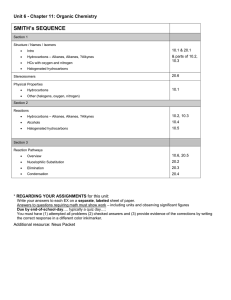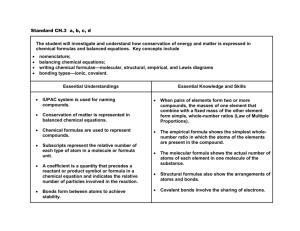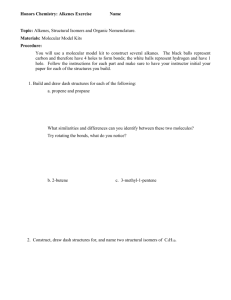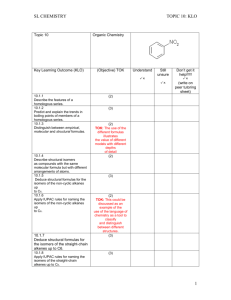Topic 10: Organic chemistry
advertisement
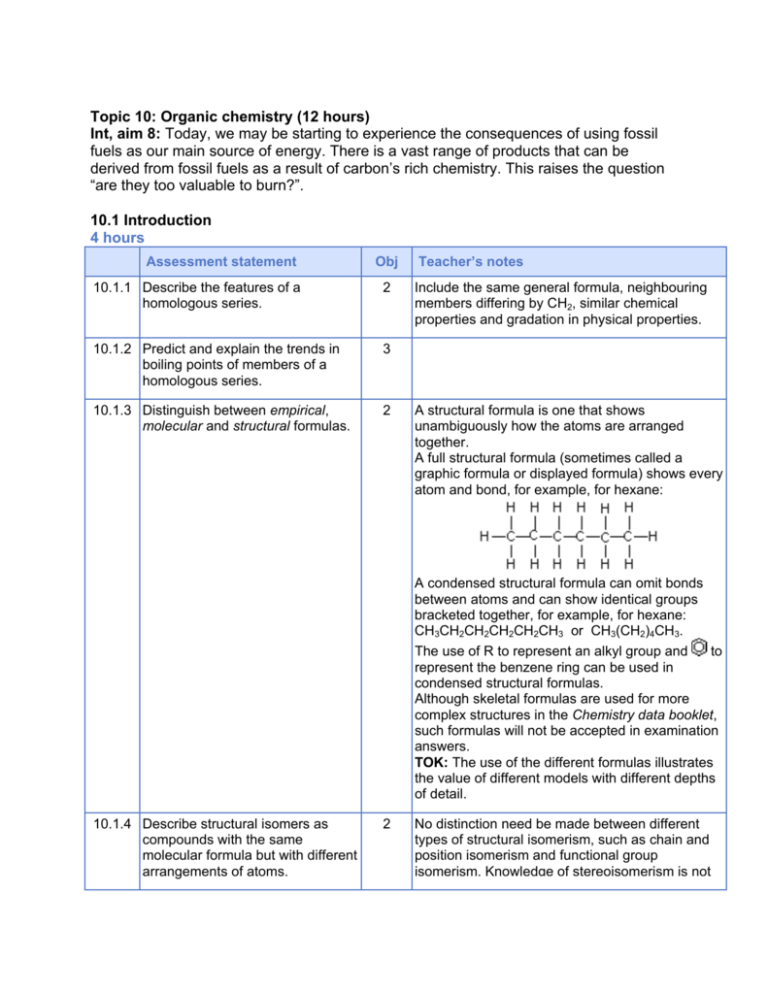
Topic 10: Organic chemistry (12 hours) Int, aim 8: Today, we may be starting to experience the consequences of using fossil fuels as our main source of energy. There is a vast range of products that can be derived from fossil fuels as a result of carbon’s rich chemistry. This raises the question “are they too valuable to burn?”. 10.1 Introduction 4 hours Assessment statement Obj 10.1.1 Describe the features of a homologous series. 2 10.1.2 Predict and explain the trends in boiling points of members of a homologous series. 3 10.1.3 Distinguish between empirical, molecular and structural formulas. 2 Teacher’s notes Include the same general formula, neighbouring members differing by CH2, similar chemical properties and gradation in physical properties. A structural formula is one that shows unambiguously how the atoms are arranged together. A full structural formula (sometimes called a graphic formula or displayed formula) shows every atom and bond, for example, for hexane: A condensed structural formula can omit bonds between atoms and can show identical groups bracketed together, for example, for hexane: CH3CH2CH2CH2CH2CH3 or CH3(CH2)4CH3. The use of R to represent an alkyl group and to represent the benzene ring can be used in condensed structural formulas. Although skeletal formulas are used for more complex structures in the Chemistry data booklet, such formulas will not be accepted in examination answers. TOK: The use of the different formulas illustrates the value of different models with different depths of detail. 10.1.4 Describe structural isomers as compounds with the same molecular formula but with different arrangements of atoms. 2 No distinction need be made between different types of structural isomerism, such as chain and position isomerism and functional group isomerism. Knowledge of stereoisomerism is not required in the core. 10.1.5 Deduce structural formulas for the isomers of the non-cyclic alkanes up to C6. 3 Include both straight-chain and branched-chain isomers. 10.1.6 Apply IUPAC rules for naming the isomers of the non-cyclic alkanes up to C6. 2 TOK: This could be discussed as an example of the use of the language of chemistry as a tool to classify and distinguish between different structures. 10.1.7 Deduce structural formulas for the isomers of the straight-chain alkenes up to C6. 3 10.1.8 Apply IUPAC rules for naming the isomers of the straight-chain alkenes up to C6. 2 The distinction between cis and trans isomers is not required. 10.1.9 Deduce structural formulas for compounds containing up to six carbon atoms with one of the following functional groups: alcohol, aldehyde, ketone, carboxylic acid and halide. 3 Condensed structural formulas can use OH, CHO, CO, COOH and F/Cl/Br/I. 10.1.10 Apply IUPAC rules for naming compounds containing up to six carbon atoms with one of the following functional groups: alcohol, aldehyde, ketone, carboxylic acid and halide. 2 10.1.11 Identify the following functional groups when present in structural formulas: amino (NH2), benzene ring ( ) and esters (RCOOR). 2 10.1.12 Identify primary, secondary and tertiary carbon atoms in alcohols and halogenoalkanes. 2 10.1.13 Discuss the volatility and solubility in water of compounds containing the functional groups listed in 10.1.9. 3 10.2 Alkanes 2 hours The terms primary, secondary and tertiary can also be applied to the molecules containing these carbon atoms. Assessment statement Obj 10.2.1 Explain the low reactivity of alkanes in terms of bond enthalpies and bond polarity. 3 10.2.2 Describe, using equations, the complete and incomplete combustion of alkanes. 2 10.2.3 Describe, using equations, the reactions of methane and ethane with chlorine and bromine. 2 10.2.4 Explain the reactions of methane and ethane with chlorine and bromine in terms of a free-radical mechanism. 3 Teacher’s notes Reference should be made to homolytic fission and the reaction steps of initiation, propagation and termination. The use of the half-arrow to represent the movement of a single electron is not required. The formulas of free radicals should include the radical symbol, for example, . 10.3 Alkenes 2 hours Assessment statement Obj Teacher’s notes 10.3.1 Describe, using equations, the reactions of alkenes with hydrogen and halogens. 2 10.3.2 Describe, using equations, the reactions of symmetrical alkenes with hydrogen halides and water. 2 10.3.3 Distinguish between alkanes and alkenes using bromine water. 2 10.3.4 Outline the polymerization of alkenes. 2 Include the formation of poly(ethene), poly(chloroethene) and poly(propene) as examples of addition polymers. Include the identification of the repeating unit, for example, –(–CH2–CH2–)n– for poly(ethene). 10.3.5 Outline the economic importance of the reactions of alkenes. 2 Aim 8: Include the hydrogenation of vegetable oils in the manufacture of margarine, the hydration of ethene in the manufacture of ethanol, and polymerization in the manufacture of plastics. 10.4 Alcohols 1 hour Assessment statement Obj Teacher’s notes 10.4.1 Describe, using equations, the complete combustion of alcohols. 2 10.4.2 Describe, using equations, the oxidation reactions of alcohols. 2 A suitable oxidizing agent is acidified potassium dichromate(VI). Equations may be balanced using the symbol [O] to represent oxygen supplied by the oxidizing agent. Include the different conditions needed to obtain good yields of different products, that is, an aldehyde by distilling off the product as it is formed, and a carboxylic acid by heating under reflux. 10.4.3 Determine the products formed by the oxidation of primary and secondary alcohols. 3 Assume that tertiary alcohols are not oxidized by potassium dichromate(VI). 10.5 Halogenoalkanes 2 hours Assessment statement Obj Teacher’s notes 10.5.1 Describe, using equations, the substitution reactions of halogenoalkanes with sodium hydroxide. 2 Aim 7: Simulations are available for this. 10.5.2 Explain the substitution reactions of halogenoalkanes with sodium hydroxide in terms of SN1 and SN2 mechanisms. 3 Reference should be made to heterolytic fission. Curly arrows should be used to represent the movement of electron pairs. For tertiary halogenoalkanes the predominant mechanism is SN1, and for primary halogenoalkanes it is SN2. Both mechanisms occur for secondary halogenoalkanes. 10.6 Reaction pathways 1 hour Assessment statement Obj Teacher’s notes 10.6.1 Deduce reaction pathways given the starting materials and the product. 3 Conversions with more than two stages will not be assessed. Reagents, conditions and equations should be included. For example, the conversion of but-2-ene to butanone can be done in two stages: but-2-ene can be heated with steam and a catalyst to form butan-2-ol, which can then be oxidized by heating with acidified potassium dichromate(VI) to form butanone. The compound and reaction types in this topic are summarized in the following scheme:

